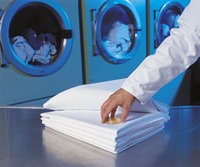| A.I.S.E. is the place to go for information about detergents and the detergents industry in Europe.
Detergents are one of the main types of products represented by A.I.S.E., and include all those products that are commonly used for washing and cleaning of textiles, dishes, floors and other hard surfaces, whether it be for household or professional use.
Because detergents mostly end up going down the drain after use and are dealt with in water treatment plants, biodegradability is important and is strictly regulated in Europe, specifically through this Regulation. |
 |
A.I.S.E.’s role, on behalf of the cleaning products industry in Europe, has for a long time now been not only to contribute to the development and implementation of effective legislation on detergents in Europe, but also to lead voluntary initiatives to reduce the environmental impact of detergents and improve communications to consumers and other users.
Detergents Regulation
The Detergents Regulation (EC) No 648/2004 went into effect in October 2005. The regulation establishes common rules to enable detergents and surfactants to be sold and used across the EU, while providing a high degree of protection to the environment and human health.
It stipulates that surfactants used in detergents must be fully biodegradable. In addition, it regulates how products should be labelled with ingredient and dosage information in order to protect human health (e.g. skin allergies) and avoid overuse of detergents.
This Regulation was updated by
Regulation (EU) No 259/2012 which imposes a ban on inorganic phosphates in domestic laundry and dishwasher detergents. Laundry detergents manufacturers must comply with it since 30 June 2013 and dishwasher detergents manufacturers at the latest by 1 January 2017. A.I.S.E.’s Detergents Working Group has published updated
implementation guidelines for manufacturers to help them comply with the amended regulation.
The implementation of the Detergents Regulation by the industry has been a success, particularly in terms of protection of human health, enabling consumers online access to the full list of ingredients, and environmental protection via enhanced biodegradability of surfactants, and development of phosphates-free formulations for consumer laundry and automatic dishwasher detergents. In the context of the review of the Regulation, industry strongly welcomes action which will help provide clearer information to consumers by addressing the existing overlaps between the Regulation and other pieces of EU chemicals legislation such as the Classification, Labelling and Packaging (CLP) Regulation, REACH, and the Biocidal Products Regulation (BPR).
A.I.S.E. response to the Inception Impact Assessment for the Detergent Regulation (EC) 648/2004 (19 Oct 2021)
The Commission has the following points on the table:
- Clarifications on the scope and definitions of the Regulation (refill sale and microbial products)
- Potential additional requirements for detergents e.g. expansion of phosphorus limitations or requirements for certain harmful substances currently not covered by the Regulation (CMR, EDs).
- Improvement of the coherence of the regulatory framework for detergents by addressing the overlaps and inconsistencies with the REACH, CLP and Biocidal Products Regulations.
- Options being considered on the instrument itself are Revising the Detergents Regulation, Repeal and incorporation of its provisions in other pieces of EU chemicals legislation, Alignment with the New Legislative Framework (‘NLF’), Non-legislative options
- A.I.S.E. has published its response to the Detergent Regulation Inception Impact Assessment. Here are our key asks:
- The scope of the Detergent Regulation should remain for cleaning products including microbial cleaning products.
- We support improvement of the coherence of the regulatory framework for detergents by addressing the overlaps and inconsistencies with the REACH, CLP and Biocidal Products Regulations.
- With regards to labelling we support the Commission study on simplification of the labelling requirements for chemicals and the use of e-labelling
- The regulations to cover risk assessment and restriction of ingredients in detergents should continue to be REACH, BPR and the General Product Safety Directive.
- The phosphorous restrictions should not be extended to other product categories
- For refill and bulk sale, guidance can provide clarity with regards how to implement already existing regulatory requirements
- The Detergent Regulation remains fit for purpose and we do not see the value of moving the Regulation under the NLF.
- It is also vital that the future framework reflects the role of voluntary schemes in driving sustainable and innovation in our sector
Link to the A.I.S.E. response you can read
here
Detergent capsules
A.I.S.E. has developed a product stewardship programme for liquid laundry detergent capsules which has led to the voluntary commitment of companies to modify their packaging. To find out more click
hereWant to know more about detergents?
The term ‘detergents’ covers not only products for washing and conditioning laundry but also a whole range of products that are commonly used for washing and cleaning of textiles, dishes, floors and other hard surfaces.
A.I.S.E. published a leaflet in 2005, which was updated in 2012, aimed at helping consumers to understand the information on detergents labels, following changes in the Detergents Regulation.
- View A.I.S.E.’s consumer leaflet on Understanding your detergents label here.
- Another leaflet specifically aimed at professional users of detergents, can be found here.